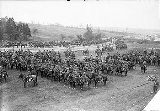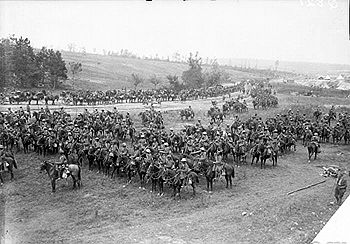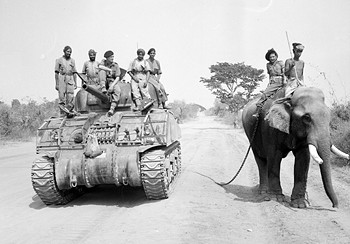
9th Royal Deccan Horse
Encyclopedia
The 9th Royal Deccan Horse was a regular cavalry regiment of the British Indian Army
, it was formed from the amalgamation of two regiments after World War I. They saw service from the Mutiny of 1857 up to and including World War II
.
who was allied with the East India Company.
During the following years the Regiment's title would change and they were known by the following titles over the years;
The Deccan Horse was frequently called for service during the 18th and 19th Centuries, winning a Victoria Cross in 1859 and was also awarded the battle honour, ‘Central India’..
The Regiment was also in action during the Second Afghan War, the Burma War, and in China during the Boxer Rebellion
.
In 1903 during Kitcheners reform
of the Indian Army the two Regiments were incorporated into the regular Indian Army with the titles XXth Deccan Horse and the 29th Lancers (Deccan Horse)..

for service on the Western Front
they were part of the 9th (Secunderbad) Cavalry Brigade of the 2nd Indian Cavalry Division
.
The 29th Lancers were also sent to France they formed part of the 8th (Lucknow) Cavalry Brigade of the 1st Indian Cavalry Division
.
Both Regiments would at times serve as Infantry in the trenches before being withdrawn for service in Palestine.
 The XXth Deccan Horse was awarded the titled Royal for their distinguished service during World War I, and in 1922 following the amalgamation of the two regiments, the Royal Deccan Horse (9th Horse) was formed.
The XXth Deccan Horse was awarded the titled Royal for their distinguished service during World War I, and in 1922 following the amalgamation of the two regiments, the Royal Deccan Horse (9th Horse) was formed.
The regiment took part in the re-conquest of Burma.
, 14th Murray's Jat Lancers
attached to the 29th Lancers , on September 23, 1918 at Kh. es Samariyeh, Jordan River, Palestine
.
Citation: Risaldar Badlu Singh was attached to 29th Lancers when "on the morning of the 23rd September 1918, his squadron charged a strong enemy position on the west bank of the river Jordan, between the river and Kh. es Samariyeh village.
"On nearing the position, Risaldar Badlu Singh realised that the squadron was suffering casualties from a small hill on the left front occupied by machine guns and 200 infantry. Without the slightest hesitation he collected six other ranks and with the greatest dash and total disregard for danger, charged and captured the position, thereby saving very heavy casualties to the squadron. He was mortally wounded on the very top of the hill when capturing one of the machine guns single handed, but all the machine guns and infantry had surrendered to him before he died.
"His valour and initiative were of the highest order."
British Indian Army
The British Indian Army, officially simply the Indian Army, was the principal army of the British Raj in India before the partition of India in 1947...
, it was formed from the amalgamation of two regiments after World War I. They saw service from the Mutiny of 1857 up to and including World War II
World War II
World War II, or the Second World War , was a global conflict lasting from 1939 to 1945, involving most of the world's nations—including all of the great powers—eventually forming two opposing military alliances: the Allies and the Axis...
.
Formation
The 9th Royal Deccan Horse can trace its formation to 1790 when it was called Asif Sah's Irregular Cavalry. Two Regiments were raised for service under the Nizam of Hyderabad in BerarBerar Sultanate
-Berar in Ancient History:Subah Berar and Gondwana the Vidarbha region known as Gulshan-e-Berar in medieval period since Khilji dynasty to mughal period according Aine-Akbari and Alimgeer Namah report the berar is hole Fourteen sarkar...
who was allied with the East India Company.
During the following years the Regiment's title would change and they were known by the following titles over the years;
- 1st Regiment, Nizam’s Cavalry
- 2nd Regiment, Nizam's Cavalry
- 1st Cavalry, Hyderabad Contingent
- 2nd Cavalry, Hyderabad Contingent
- 1st Lancers, Hyderabad Contingent
- 2nd Lancers, Hyderabad Contingent.
The Deccan Horse was frequently called for service during the 18th and 19th Centuries, winning a Victoria Cross in 1859 and was also awarded the battle honour, ‘Central India’..
The Regiment was also in action during the Second Afghan War, the Burma War, and in China during the Boxer Rebellion
Boxer Rebellion
The Boxer Rebellion, also called the Boxer Uprising by some historians or the Righteous Harmony Society Movement in northern China, was a proto-nationalist movement by the "Righteous Harmony Society" , or "Righteous Fists of Harmony" or "Society of Righteous and Harmonious Fists" , in China between...
.
In 1903 during Kitcheners reform
Kitchener Reforms
The Kitchener Reforms of the Indian Army began in 1903 when Lord Kitchener of Khartoum, newly appointed Commander-in-Chief, India, completed the unification of the three armies of the former Presidencies , and also the Punjab Frontier Force, the Hyderabad Contingent and other local forces, into one...
of the Indian Army the two Regiments were incorporated into the regular Indian Army with the titles XXth Deccan Horse and the 29th Lancers (Deccan Horse)..

World War I
The 20th Deccan Horse was sent to FranceFrance
The French Republic , The French Republic , The French Republic , (commonly known as France , is a unitary semi-presidential republic in Western Europe with several overseas territories and islands located on other continents and in the Indian, Pacific, and Atlantic oceans. Metropolitan France...
for service on the Western Front
Western Front (World War I)
Following the outbreak of World War I in 1914, the German Army opened the Western Front by first invading Luxembourg and Belgium, then gaining military control of important industrial regions in France. The tide of the advance was dramatically turned with the Battle of the Marne...
they were part of the 9th (Secunderbad) Cavalry Brigade of the 2nd Indian Cavalry Division
2nd Indian Cavalry Division
The 2nd Indian Cavalry Division was a regular division of the British Indian Army during World War I.-History:The division sailed for France from Bombay on October 16, 1914, under the command of Major General G A Cookson. During the war the division would serve in the trenches as infantry...
.
The 29th Lancers were also sent to France they formed part of the 8th (Lucknow) Cavalry Brigade of the 1st Indian Cavalry Division
1st Indian Cavalry Division
The 1st Indian Cavalry Division was a regular division of the British Indian Army. The division sailed for France from Bombay on October 16, 1914 , under the command of Major General H D Fanshawe. The division was re designated the 4th Cavalry Division in November 1916. During the war the Division...
.
Both Regiments would at times serve as Infantry in the trenches before being withdrawn for service in Palestine.
Amalgamation

World War II
During the Second World War,the Regiment converted to tanks, and became part of the 255th Indian Tank Brigade255th Indian Tank Brigade
The 255th Indian Tank Brigade was an armoured brigade of the Indian Army during World War II. It was part of the Fourteenth Army and saw action in the Burma Campaign...
The regiment took part in the re-conquest of Burma.
Victoria Cross
Risaldar Badlu SinghBadlu Singh
Badlu Singh VC was an Indian recipient of the Victoria Cross, the highest and most prestigious award for gallantry in the face of the enemy that can be awarded to British and Commonwealth forces....
, 14th Murray's Jat Lancers
14th Murray's Jat Lancers
The 14th Murray's Jat Lancers, was a cavalry regiment of the British Indian Army.The regiment was first raised for the East India Company by Captain Murray. Like all regiments of the Indian Army the 14th Murray’s Jat Lancers underwent many name changes in the various reorganisations. They are...
attached to the 29th Lancers , on September 23, 1918 at Kh. es Samariyeh, Jordan River, Palestine
Palestine
Palestine is a conventional name, among others, used to describe the geographic region between the Mediterranean Sea and the Jordan River, and various adjoining lands....
.
Citation: Risaldar Badlu Singh was attached to 29th Lancers when "on the morning of the 23rd September 1918, his squadron charged a strong enemy position on the west bank of the river Jordan, between the river and Kh. es Samariyeh village.
"On nearing the position, Risaldar Badlu Singh realised that the squadron was suffering casualties from a small hill on the left front occupied by machine guns and 200 infantry. Without the slightest hesitation he collected six other ranks and with the greatest dash and total disregard for danger, charged and captured the position, thereby saving very heavy casualties to the squadron. He was mortally wounded on the very top of the hill when capturing one of the machine guns single handed, but all the machine guns and infantry had surrendered to him before he died.
"His valour and initiative were of the highest order."
Konsal Singh
- Description Medal card of Konsal Singh *
- 20th Deccan Horse - Risaldar
- Date - 1914-1920

